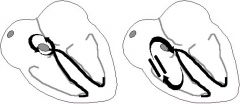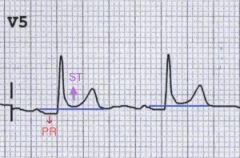![]()
![]()
![]()
Use LEFT and RIGHT arrow keys to navigate between flashcards;
Use UP and DOWN arrow keys to flip the card;
H to show hint;
A reads text to speech;
49 Cards in this Set
- Front
- Back
- 3rd side (hint)
|
What analogy do we use to explain conduction through the ventricles |
Driving: Atria = suburbs AV node = On-ramp Ventricle = Highway but if the conduction originates in the ventricles, it is like being in the veld, it is difficult to get onto the highway therefore cannot go at the same speed |
|
|
|
How does nervous stimuli affect the heart? |
Para-/sympathetic stimulus does not affect regularity but affects rate |
|
|
|
Is a sinus arrythmia normal? |
Yes, but it does not necessarily mean that the person is healthy |
|
|
|
Where does the impulse normally originate from? |
SA node |
|
|
|
What is normal with a SA nodal pacemaker? |
Sinus Rhythm Sinus Arrythmia Sinus Tachycardia Sinus Bradycardia |
|
|
|
What are the characteristics of sinus rhythm? |
Normal rate, regular rhythm, narrow QRS |
|
|
|
What are the characteristics of sinus arrythmia? |
Cyclic rate variation with breathing |
|
|
|
When can you have an abnormal SA node pacemaker conduction |
1) Underlying systemic disease 2) SAN dysfunction such as: Sinus bradycardia, SAN exit block, SAN arrest (results in physiological pacemaker) |
|
|
|
What about when the impulse originates from the atria? |
This is abnormal. You can get: 1) Fast rhythm due to automaticity 2) Fast or slow rhythm due to reentry mechanism in atria |
|
|
|
When do you get a fast rhythm due to automaticity? |
Atrial tachycardia Multifocal atrial tachycardia |
|
|
|
What are the characteristics of Atrial Tachycardia? |
Fast, Regular, narrow QRS, single abnormal P shape |
|
|
|
What are the characteristic of MAT? |
Fast, Irregular, narrow WRS, many abnormal P shapes |
|
|
|
What is a reentry mechanism? |
The cause of the arrhythmia is due to the electric signal not completing the normal circuit, but rather an alternative circuit looping back upon itself. It can be made of single or multiple circuits. Analogy of the car splitting at the road block |
|
|
|
When do you get abnormal rhythm due to reentry mechanisms in the atria? |
Atrial Flutter Atrial Fibrillation |
|
|
|
What are the characteristics of atrial flutter |
Fast, regular, narrow QRS, Sawtooth pattern and block (2:1, 3:1) |
Single circuit |
|
|
What are the characteristics of atrial fibrillation? |
Variable rate, irregular, narrow QRS, no P, Squiggly baseline |
Multiple Circuits |
|
|
What if the impulse originated from the AV junction? |
You get: Fast rhythm due to reentry mechanism Slower rhythm due to a physiological pacemaker |
|
|
|
There's that reentry thing again. Please explain it in this context, I didn't quite understand |
A prerequisite for re-entry is the presence oftwo pathways with differing conduction velocities that connect two points (in this case the atria with the ventricles) that are at the same point i.e. the AV node. The signal splits in two at arrival,but no arrhythmia is initiated as the slow signal becomes extinct when it meetsthe fast signal. However, after an extrasystole the fast pathway isstill refractory and conduction is by the slow pathway. The signal that reachesthe His by the slow pathway may find the fast pathway conducting and return tothe atria. This may set in motion a re-entry pathwaythrough the AV node resulting in AV nodal tachycardia. |
|
|
|
So when do you get a reentry mechanism happening at the AV node? |
AV nodal reentry tachycardia AV reentry tacahycardia |
|
|
|
What is AVNRT and what are it's characteristics? |
Born with extra excitatory tissue, treated with vagal maneuver (increase intraabdo pressure to stimulate vagus nerve). This is a circuit within AV node
Very fast, regular, narrow QRS, shorter PR (P often embedded in QRS complex) ( P may be seen retrograde in II, III, aVF) |

1st = AVNRT |
|
|
What is AVRT and what are it's characteristics? |
Underlying disease: Wolf-Parkinson-White. This circuit does not necessarily have to be completed within AV node. Fast, regular, narrow or wide, short PR, |

2nd = AVRT |
|
|
When do you get a slower rhythm due to physiological pacemaker? |
Junctional Rhythm |
|
|
|
What are the characteristics of a Junctional Rhythm? |
Slow, Regular, Narrow QRS, noP/neg P/P after |
|
|
|
If the impulse originates from the ventricle is it abnormal and what type do you get? |
Yes, it is. Fast rhythm due to ventricular focus firing Slower rhythm due to back-up pacemaker |
|
|
|
Give examples of a fast rhythm generated by ventricular focus firing |
Monomorophic ventricular tachycardia Polymorphic ventricular tachycardia |
|
|
|
What is monomorphic ventricular tachycardia? What are its characteristics? |
Stimulus originates from single point in ventricles.
Fast, regular, Wide QRS, no P
|
|
|
|
What is polymorphic ventricular tachycardia? |
Stimulus originates from multiple points in ventricles |
|
|
|
What are the types of P-VT that you can get? |
Torsades de pointes V fib |
|
|
|
Describe Torsades de pointes |
Commonly caused by MI. Has characteristic "twisting" morphology. Fast, irregular, wide mixed QRS (Prolonged QT) |
|
|
|
Describe V Fib
|
Rapid, irregular activity in the ventricles Fast, irregular, no P waves QRS complexes or T waves. |
|
|
|
When do you get a slow rhythm due to a backup pacemaker? |
Idioventricular rhythm |
|
|
|
Tell me about the characteristics of an idioventricular rhythm |
Usually associated with other disease such as Sinus Arrest Slow, regular, wide QRS, no P linked to QRS |
NB It is also called a ventricular escape rhythm |
|
|
What are the abnormal impulses that may be superimposed on a rhythm strip?
|
Premature atrial complexes Premature junctional complexes Premature ventricular complexes |
|
|
|
Describe PAC |
Early P, normal QRS wave |
|
|
|
Describe PJC |
no P, early normal QRS wave |
|
|
|
Desrcibe PVC |
no P, early wide QRS |
|
|
|
What are the differences between premature complexes and physiological pacemakers? |
Premature complexes: Superimposed on underlying rhythm, wave is premature, an electrical abnormality Physiological pacemaker: Primary pacemaker too slow/stopped, wave arises after prolonged pause, electrical safety backup |
|
|
|
What are the different ways that impulses can be conducted through the atria? |
Normal sinus rhythm 1st degree block 2nd degree Type I block Other: Pericarditis |
|
|
|
Outline impulse conduction in sinus rhythm |
Normal P-R interval 120-200ms regular, narrow QRS |
|
|
|
What is a first degree block and what are its characteristics? |
A prolongation of PR interval >200ms, it a sign of slowed impulse conduction through atria. It does not give bradycardia slower,Fixed PR >200ms, regular, narrow QRS |
|
|
|
What is a second degree Type I block? |
Progressive prolongation of the PR interval culminating in a non-conducted P wave i.e. a dropped beat, only one QRS complex is dropped Cycles of progressively increased PR with last QRS dropped: irregular/group beating, narrow QRS |
|
|
|
What is pericarditis and how does it present on ECG?
|

Inflammation of the pericardium produces characteristic chest pain (retrosternal, pleuritic, worse on lying flat, relieved by sitting forward), tachycardia and dyspnoea. PR interval depressed, elevated ST segment |
|
|
|
What are the different presentations of impulse conduction through the AV junction? |
Normal (represents vagal tone) 2nd degree Type II block 3rd degree Block |
|
|
|
What is a 2nd degree type II block and how does it present on ECG? |
Intermittent non-conducted P waves without progressive prolongation of the PR interval. Usually due to infarction, ischaemia, necrosis RR interval surrounding the dropped beat(s) is an exact multiple of the preceding RR interval No warning signs before dropped beat fast/slow, normal PR, dropped QRSs, group/irregu;ar, narrow/wide |
|
|
|
What is a 3rd degree block and how does it present on ECG? |
Complete blockage of AV node, ventricular pacemaker takes over Slow, regular, QRS wider than N, no relationship with P |
|
|
|
Tell me about impulse conduction through Ventricles |
Normal is fast: QRS<120ms, narrow Delayed < 120 ms |
|
|
|
When can conduction through ventricles be delayed? |
Conduction pathways (Bundle of His, Bundle branches, Fascicles): LBBB, RBBB, Hemiblocks (i.e. fasicular blocks) Muscle: Infarcts, electrolyte abnormalities, drug toxicity, diseases (e.g. pericarditis or hypertrophy) Can cause wide QRS, ST elevated/depressed, prolonged QT, T waves abnormal size and polarity |
|
|
|
What can we learn from the width of the QRS? |
Narrow = origin is above AV junctione.g. sinus tachy/brady, Afl, Afib Wide = a) impulse origin above AV junction b) origin is above AV junction (supraventricular pacemaker) but conduction is slowed past AV e.g. VT vs SVT + LBBB, vent pacemaker vs sinus brady + LBBB |
|
|
|
What analogy do we use to explain Blocks? |
Relationships: Normal = 2 people in close relationship 1st degree = Marriage, but are distant 2nd degree Type I = Close but drift apart until one night stand 2nd degree Type II = Unexpected one night stand but still close. The more unexpected one night stands, the more likely to stop working. 3rd degree: Divorced but sometimes meet at elevator |
|

